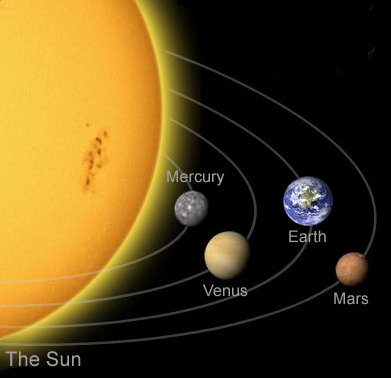
by John P. Pratt
29 Sep 2014, 1 Deer (SR)
©2014 by John P. Pratt. All rights Reserved.
| 1. Orbit of Mars |
| 1.1 Full Sky Path |
| 1.2 Retrograde Motion |
| 2. Calendar Pattern |
| 3. Patriarchs |
| 4. Priesthoods |
| 4.1 John the Baptist |
| 4.2 Aaron |
| 4.3 Priesthood Restorations |
| 5. Temples |
| 5.1 Solomon's Temple |
| 5.2 Feast of Dedication |
| 5.3 Salt Lake Temple |
| 6. Life of Jesus Christ |
| 7. Conclusion |
| Notes |
 |
The orbit of Mars and of planets even further from the sun appear very different from those of Venus and Mercury, which both have sacred calendars associated with them. Looking at the standard picture of the solar system as shown in Figure 1, all is very orderly, and one might expect the planets to appears to travel in smooth arcs across the sky. But that illustration is a view from space where both the sun and stars appear to be in fixed positions and the planets are all moving counter-clockwise around the sun.
It was hailed as a great break through when it was realized that the solar system is much easier to explain when viewed from space in that manner. So today, tables of planetary orbital periods list the periods relative to the stars.
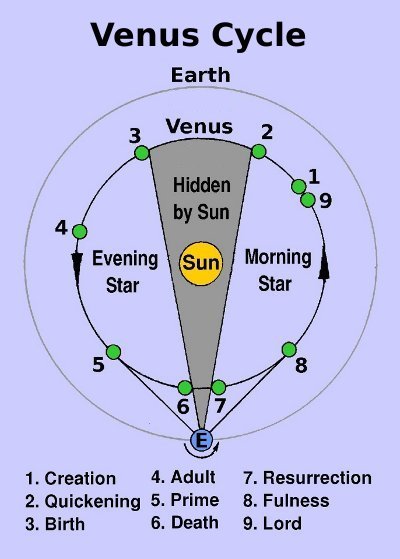 |
The orbit of Venus in Figure 2 is shown as seen from a perspective where both the sun and the earth do not appear to be moving. It shows the orbital points marking its nine phases. The Mars Calendar is expected to have nine similar points, which need to be determined. Note that while the orbital period of Venus is about 585 days, the period of the earth is 0 days because it is at a fixed place in this illustration. Venus can be seen as either an evening or morning star. It can rise either in the east or the west, and then it stays in that area of the sky, never straying far from the sun. It can never be seen at midnight, hence it is called an Evening Star or a Morning Star.
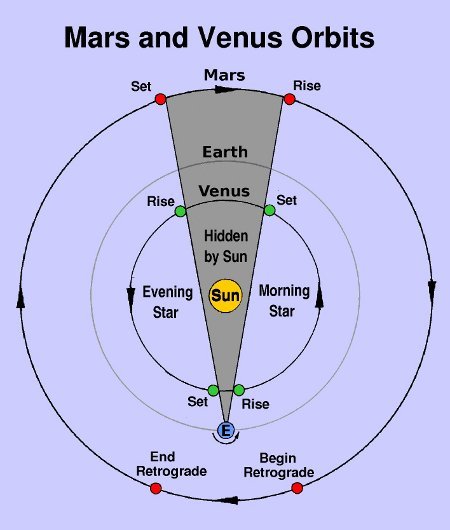 |
The reason for all of this detail is that the very different appearance of the motion of the outer planets might lead to a very different calendar. And yet, the phases of the Venus calendar appear to the phases of life in general. Do those same phases also apply to a Mars calendar? Before answering that question, let's look at one more unusual feature of the outer planets.
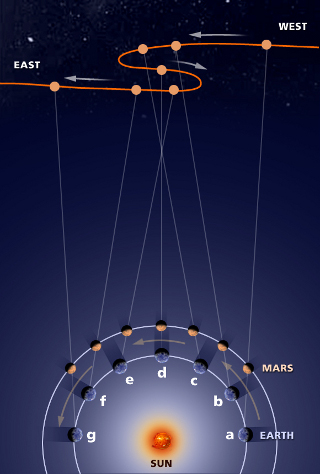 |
A planetary calendar is a fixed pattern that indicates the approximate average position of that planet in the sky as seen from the earth. After knowing the period of the planet, it is then necessary to determine the key places in the orbit which should be marked on the calendar. For sacred calendars, it is not sufficient to think of the obvious places used by men, but to discover the positions which are marked on God's sacred version of the calendar as holy days.
If there is a sacred Mars calendar, then what is its pattern of holy days? One reason it has seemed clear to me that there is a Mars calendar is that the life of John the Baptist is an exact number of Mars cycles. Moreover, there have been several indications that Mars is a priesthood calendar.
Earlier papers have shown that the 13-day trecena is the fundamental unit of all of these planetary calendars. Their orbits appear to have all been created to be almost exact multiples of that unit. In the case of Mars, it is amazingly close, the cycle being 779.93651 days, almost exactly 780 days which is exactly 60 trecenas. And 780 days is also exactly three Sacred Rounds of 260 days each.
Supposing there is a Mars calendar, how can we know if the right pattern of holy days has been found? It is the same as with the Venus and Mercury calendars. The correctness is verified by there being many more sacred events occur on holy days than could be expected by random chance.
The holy days on the Venus calendar were discovered partly from believing Aztec traditions about Venus being "born" when it rises in the west, "dying" when it sets in the west, and "resurrecting" when it rises in the east. But what about Mars? It only has one phase when hidden in the sun, not two as does Venus. How can it die and appear to disappear underground, and then rise again? It only disappears once, not twice.
That simple question halted research on this calendar for two decades. Then an answer appeared just last week that seems to work. Mars does not die. It is "translated". "Translated" in this context refers to a change made in the bodies of certain holy people such as the ancient prophet Enoch (Gen. 5:24; D&C 107:48-49). They do not taste of death in the usual manner. It is my understanding that their bodies remain healthy, young, and free from physical pain, possibly for long periods of time. But they are still not immortal and later will also be resurrected to immortality.
If so, then the period of disappearance in sunlight corresponds to Mars being hidden in the womb, during the period of "Quickening" (same as Venus). It is "born" when it rises in the east just before the sun. These are two proposed holy days: Quickening when Mars sets and Birth when it rises.
In the study of the Venus Calendar, it became clear that the next phase after birth began a period of backsliding from the innocence of youth. It was called "Adult." The Mayan priests said it was the time when evil enters a person's life. The following phase was called "Prime" because it occurred near the brightest point in the cycle of Venus. But further research showed that it corresponds to the time of "rebirth" which ends the backsliding to move forward again. That was not obvious at all with the planets Venus and Mercury, because they do not actually appear to move backwards.
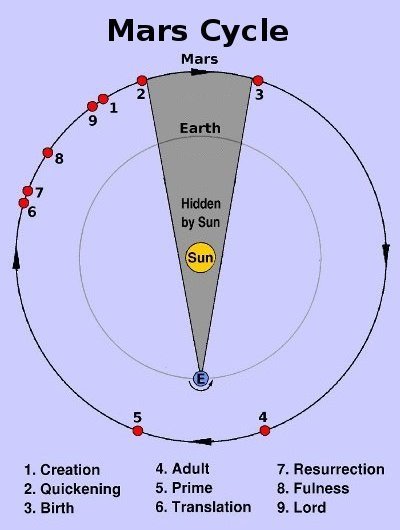 |
After Prime comes Death on the Venus cycle, where the planet sets as an Evening Star. Because Mars does not set, it is proposed that the corresponding holy day be called "Translation." On the Venus Calendar, the period between death and resurrection is one trecena, so it is proposed that be the same length on the Mars Calendar.
On the Venus Calendar, the initial phase (Creation) of the cycle occurs while the planet is still visible as the Morning Star. Similarly, it is proposed that the last stages after Resurrection (Fulness and Lord) and initial stage of the next cycle (Creation) all occur near the end of the visible part of the Mars cycle. It is proposed that they are the same length as in the Venus Cycle, namely that Creation is 3 trecenas, and Lord is one trecena.
That leaves only one point in question, Fulness, without another pattern to follow. It was decided to put that holy day 3 trecenas after Resurrection so that the Ascension of Jesus Christ, forty days after his Resurrection (Acts 1:3), would be on that holy day. That day was Thu 12 May 33 and has not yet been mentioned in my articles, but below it will be seen that the day most likely really is the correct choice for "Fulness." Figure 5 shows the location of all nine orbital positions of these holy days.
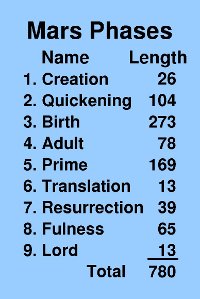 |
One more question that needs to be answered is about when the day begins. The Venus and Mercury Calendars begin the day at midnight when neither of those planets can ever be seen. If it began near sunrise or sunset, then the planet could rise on one day before the sun and then switch to another after sunrise. That could be very confusing. Beginning at midnight leaves no question about the Venus day.
With Mars and the other outer planets, it is the opposite. They can be up all night. If the Mars day were to begin at midnight, then they would have the problem of whether an observation of Mars was on the day before midnight or the following day. For that purpose, astronomers use a day which begins at noon, when the stars are not visible. Similarly it is proposed that the Mars and the outer planet calendars begin the day at noon.
That choice answers another question. As this paper continues, it will become clear the Mars Calendar is a priesthood calendar. The Priest Calendar proposed in my work begins at noon. It was patterned after the course of the Jewish Priests, and the new courses began at noon on Saturday. It makes sense that the Priest Calendar would be synchronized with the Mars calendar if it is for priesthood purposes. Once interesting feature of the Priest Calendar is that the holy day is the first day of the week, which is the afternoon of Saturday and the morning of Sunday. So it accommodates both Jews and Christians.
Now let us turn to looking at some precise dates on the calendar, after the above pattern is fit to the actual orbit. As we look at these dates, keep in mind that nearly every date has been published long ago, having been determined by other criteria. The fact that so many of these dates also precisely fit the proposed Mars Calendar (abbreviated Ma) is strong evidence that the proposed calendar pattern is indeed correct, and that the Creator actually has been using it throughout history.
In most of the following discussion, formerly proposed dates of events will not be repeated here because it would become so tedious. All of them are listed in the Religious Chronology page. That page has been updated to also include the date on the Mars Calendar in the right hand column in the case where the event fell on a Mars holy day.
 |
Consider just the date proposed for when Adam first breathed the breath of life. It was chosen because it was the day representing birth on the Venus and Mercury, and Perpetual Hebrew Calendars. Later it was found that it was also the day representing birth on the Uniform Enoch Calendar. Now it is discovered that it was also 1 Birth on the Mars Calendar. To this author that is amazing enough to indicate that it was not the result of random chance. It confirms the existence of the Mars Calendar and that when the solar system was created, all of this was planned.
Remember that only one day in over two years is the day 1 Birth. The chances are only 1 in 780 that any randomly picked date would happen to fall on 1 Birth (Ma) by chance. In this case, all of the patriarchs were already known to have been born on the first day of a trecena, but still that makes the odds 1 in 60 for each one. Looking again at Figure 5, it means the mean position of Mars was right at position 3 in that diagram.
The odds against all of those dates falling on the day of birth on so many sacred calendars are far beyond chance. When the date for Adam of Sat 17 Oct 4070 BC was first announced in 2003, it was in a section of the article entitled "The Perfect Birthday".[2] That title was chosen because the day represented birth on three calendars, which is only expected to occur by chance once every 9 x 584 = 5,256 years. The only example that occurs in the 4,000 years BC just happens to be right in the year that was indicated for Adam. Factoring in the Uniform Enoch reduces the odds by a factor of 4, to once in 20,000 years. Now with the added witness of the Mars Calendars the date becomes 60 times more rare, only expected to occur by chance once in over a million years.
There is one new date included in Table 2. It is the day of the founding of Enoch's city of Zion. In former papers it was suggested that the day on which the city was founded coincided with the day Enoch was blessed by Adam.[3] Now it seems more likely that there was a week separating the two events, perhaps in a week long celebration. The city was most likely founded on the first day of Passover (UE), Sat 15 Sep 3313 BC, which was 1 Reed (SR), 1 Prime (Ma), 1 Resurrection (V), 1 Creation (M), and 1 Bilgah (P). Then Adam blessed him on the Last Day of Passover (UE) a week later, on his sixty-fifth birthday on the Feast of Tabernacles (PHC), Autumn Equinox (E), Atonement (J), and 1 Immer (P).
Another event listed in Table 2 is the day on which Genesis tells us that the flood waters abated. That was just after the mountains were first seen and essentially corresponds to the day of the rebirth of the earth after its baptism. The day was 1 Water (SR) and 1 Birth on the Mars Calendar.
It should also be mentioned that many of the wives of those patriarchs were also born and died on holy days on the Mars Calendar. They are not listed in a table because only a few of those wives' birth and death dates are known. One that again deserves special mention is Rebekah, wife of Isaac. In past articles she has been singled out as having had an amazing length of life, being an exact number of Sacred Rounds, as well as holy on many other sacred calendars. Now it turns out it was also an exact number of Mars cycles and that she was born and died on 1 Prime (Ma).
For many years it has been suspected that Mars would turn out to be a priesthood calendar. That was partly because the length of the life of John the Baptist turned out to be an exact number of Mars cycles. First let us consider more about his life and then look at other priesthood dates.
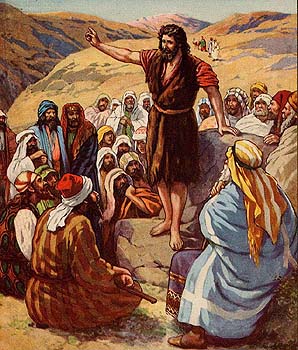 |
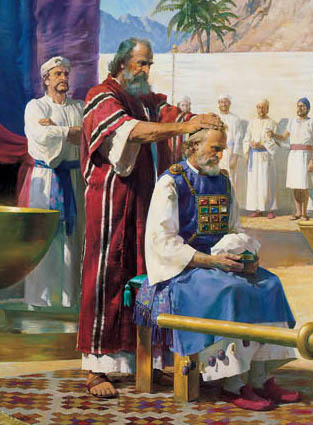 |
When was Aaron born? There has been a proposed date in my records for some time. It has not seemed worth publishing because it was not particularly amazing, even though it was a sacred day on four calendars. The day is Sun 14 Nov 1546 BC am. That day was 1 Kislev (PHC), Firstfruits (J), 1 Huppah (P) and 7 Condor (SR). That latter date has puzzled me because most of the ancient patriarchs were born on a day 1 on the Sacred Round.
When the birth dates of the twelve sons of Jacob were being sought, it was amazing to me that two of them were born on 7 Condor: Levi and Judah. When it was researched more why the day 7 Condor might be significant, it was realized that the circumcision date would fall on 1 Temple, the Sacred Round day signifying birth. It was noted that Levi's "circumcision was on 1 Temple, which fits because the Levites were temple workers."[5]
Now much more significance can be noted. The day of Aaron's circumcision, Sun 21 Nov 1546 BC am, was not only 1 Temple (SR), it was also 1 Summer (UE), 1 Jeshebeab (P), 1 Lord (V), 1 Birth (UV), 1 Quickening (M), 1 Fulness (UM), and now it can be added 0 Birth (Ma). That is holy on eight sacred calendars, with two on them on a day for birth. But more importantly, that day was 0 Birth on the Mars calendar, which is associated with priesthood, especially the Aaronic priesthood, as in the case of John the Baptist.
In this work on sacred calendars little has been said about the dates of the restoration in modern times of either the Aaronic or the Melchizedek priesthood. The first of those two dates was reported in LDS church history as being Fri 15 May 1829 when John the Baptist returned as a resurrected being and bestowed the priesthood on two men (JS-H 1:72). The second date was not recorded and has not been known. The best estimate has been near the month of May in 1829.
On the other hand, dates have been proposed for priesthood ordinations for ancient patriarchs such as Enoch. If they are to be taken seriously, then what about big priesthood ordination dates in modern times, with known dates? If they follow the same pattern, it could add credence to the ancient proposed dates.
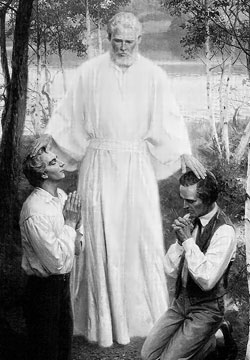 |
According to all that has been discovered in my sacred calendar work, if the date of the restoration of the Aaronic Priesthood had not been known, then years ago I would have confidently asserted that the date was Sat 16 May 1829 in the afternoon. That day was sacred on five known sacred calendars. It was the Summer Equinox (UE), a holy day (P) and that seemed important, 13 Wind (SR), 0 Birth (M), and 0 Lord (M).
Is it possible that the traditional date from LDS Church history is in error? It seems very possible because many of the early key dates were not recorded, such as the date of the First Vision, or the date of the restoration of the Melchizedek Priesthood. There were only two mortal witnesses of the event, Joseph Smith and Oliver Cowdery, and in later trying to remember the date might they have missed it by one day. Before drawing any conclusion, let us consider more evidence.
LDS Church history records that sometime after the restoration of the Aaronic Priesthood that Peter, James and John also appeared to Joseph Smith and Oliver Cowdery. No date was recorded but some church members recorded the story as they remember it being told to them.
In 1881 Addison Everett recalled that he heard Joseph Smith relate that while escaping a mob from Colesville, NY, that:
In a carefully researched article, after quoting that account and piecing together several clues, Larry C. Porter concluded that, "Therefore, all the information we now have, taken together, seems to place the date of the restoration of the Melchizedek Priesthood between 15 and about 29 May 1829."[8]"...Joseph and Oliver went to the woods in a few rods, it being night, and they traveled until Oliver was exhausted and Joseph almost carried him through mud and water. They traveled all night and just at the break of day Oliver gave out entirely and exclaimed 'O Lord, How long Brother Joseph have we got to endure this thing?'
"Brother Joseph said that at that very time Peter, James and John came to them and ordained them to the apostleship.
"They had 16 or 17 miles to travel to get back to Mr. Hale's, his father-in-law, and Oliver did not complain any more of fatigue."[7]
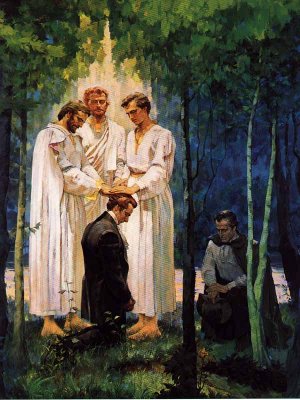 |
That time was holy on four previously known calendars: Firstfruits (E), first day of the seventh time period (UJ), a holy day (P), and 1 Condor (SR). Holiness on the Priest Calendar seems almost essential. Moreover, the day 1 Condor (SR) is probably significant. In my web page discussing the meaning of each of the twenty Sacred Round glyphs (such as Condor), it mentions that the two preceding ones (Jaguar and Eagle) seem to represent orders of priesthood. It is also pointed out that the Condor flies higher than the eagle.[9] Thus, it might represent another order of priesthood.
Even with all of these coinciding holy days, it was not enough to publish these dates. But now the Mars Calendar, a priesthood calendar, has tipped the scales.
On the Mars Calendar, Sat 16 May 1829 pm was 0 Lord and Sun 31 May 1829 am* was 1 Creation. Thus both dates are holy days on the Mars Calendar! That is in addition to both already being holy on several other sacred calendars. The fact that Mars holy days are so rare and that both of these dates are holy days on this priesthood calendar provides the confidence level needed to assert that both of these dates are correct. It is also a confirmation that the Mars Calendar day beginning at noon, the same as the Priest Calendar, is correct. That was indeed a strange time to restore the Melchizedek Priesthood, at day break, and yet it was right on time according to the Mars Calendar.
The two dates together form a pair at the end of one cycle (Lord) and the beginning of the next (Creation). It suggests that with the restoration of the Melchizedek Priesthood, and entire new priesthood cycle was beginning.
When deriving the pattern of the Mars calendar, the day "Fulness" was chosen because it was the day of the Ascension of Jesus Christ. That was the fortieth day after the Resurrection, being Thu 12 May AD 33. That day has not hitherto been published in my work because it did not seem amazing, even though it fell on a "triple birth" day. It was 1 Birth on both the Mercury and Uniform Mercury Calendars, and also 1 Temple, which represents birth on the Sacred Round. But that is only three sacred calendars and not very rare.
Now the Mars Calendar changes all of that. As will be seen from the dedication dates of three temples now to be discussed, the day was important enough to be declared "Fulness" on the Mars calendar.
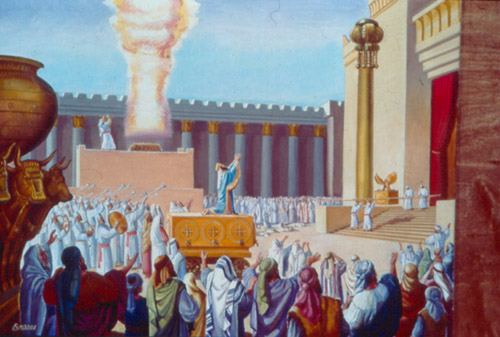 |
That indicated day was not only the Feast of Tabernacles (PHC), but also the Autumn Equinox (E), Passover (UE), Atonement (J), 1 Harim (P), 1 Water (SR), 1 Fulness (M), and 1 Quickening (UM). So before now it was already known to be holy on 8 sacred calendars. Those were far more than ample to testify of the correctness of the date. But now a new witness emerges: It was also 1 Fulness on the Mars Calendar. By itself that could be a chance coincidence, as could any one of the calendar alignments. But it is just one of three witnesses of the connection of 1 Fulness (Ma) to temples.
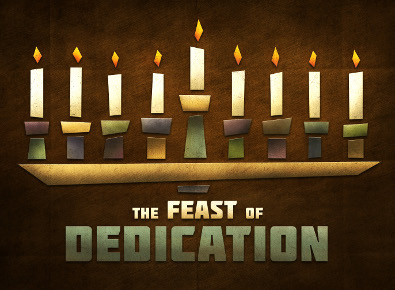 |
This date was published in a recent article on the Uniform Venus Calendar. The day on that calendar is the same as that of the Savior's birth. That was taken as significant enough to be a factor in choosing a correlation that would make both days a holy day on that calendar.[11] Further developments showed that was not true. Those days were indeed not one of the nine known sacred days on the Uniform Venus Calendar. That correction was also published.[12]
Now the Feast of Dedication comes back into the limelight. That day was also 1 Fulness on the Mars Calendar, exactly as was the day of dedication of the Temple of Solomon. There is only a 1 in 780 probability of a date known independently from history to fall on 1 Fulness on the Mars Calendar. Anything more rare than 1 in 20 is usually considered significant in statistics. So there is a second witness linking 1 Fulness to temple dedications.
Thus we see that the Feast of Dedication is linked to the ascension of Christ on the Mars Calendar rather than the birth of Christ on the Uniform Venus Calendar. That makes more sense symbolically too, as Christ's body is His temple, and His ascension could very well have been linked to receiving some kind of "Fulness". Of the three names for the feast commemorating this event, now that the symbolism is better understood, in my work it will probably be called the "Feast of Dedication."
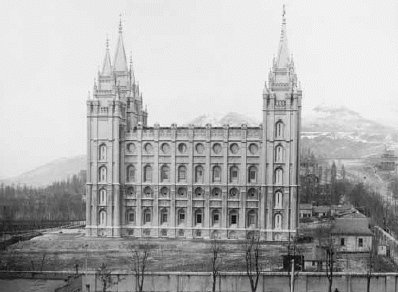 |
The day qualified to be in my database simply because it is holy on at least one sacred calendar: It was 1 Flint (SR), a day representing sacrifice. Any day 1 on the Sacred Round is automatically a sacred day on both the Mercury and Uniform Mercury Calendars. In this case those days were 1 Death (M) and 1 Adult (UM). Those are both foreboding rather than encouraging, and they have both seemed somewhat random to me, rather than being additional witnesses of anything.
Now with the Mars Calendar, this date can shine in its own light. The day 6 Apr 1893 was also the day 1 Fulness on the Mars Calendar, the same as both the dedication of the Temple of Solomon and also the rededication of the Second Temple. Again, the probability of that happening by chance is again 1 in 780 for a date known from history.
Thus, together these three temple dedications form a powerful triple witness both of the day 1 Fulness (Ma) being correct and important, and also of those three dedication dates being somehow planned to be on this holy Mars Calendar date.
In the recent review papers it has been noted that the key dates in history seem to involve both Adam and the Fall as well as the Resurrection of Jesus Christ. The two form a pair because Adam introduced death and Jesus overcame it. If that is indeed a major theme, then one would expect it to be represented in the Mars Calendar also. Let us now see how that is indeed the case by first looking at the dates of key events in the life of Christ on the Mars Calendar.
The date of the Resurrection falls on 0 Resurrection on the proposed Mars Calendar, but that is no amazing coincidence. There was no known former pattern for exactly when Resurrection should occur in the calendar pattern, so the day of the Resurrection was chosen to be 0 Resurrection. That being said, let us see what other dates fall on 0 or 1 Resurrection as second witnesses that it was a correct choice.
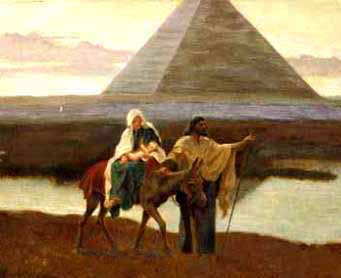 |
That is not a chance coincidence. It seems to be telling us there is a real connection between the Return from Egypt and the Resurrection.
Next we see that the day of the Flight to Egypt which began that trip fell on 1 Adult (Ma). That is the day that Evil enters a persons life, and its corresponding day on the Sacred Round is 1 Dragon. The day of both the beginning and end of the trip was 1 Dragon (SR). That is a match. And on the Venus Calendar the days are 1 Birth and 1 Death (V).
Putting all of this together seems to answer a nagging question. Why do so many prophets have to travel to Egypt and return. It happened to Abraham, Jacob, Joseph, and Jesus. In fact, it was prophesied that God would call His Son out of Egypt (Hosea 11:1, Mat. 2:15). What is all of that about?
These different calendars seem to tell a story. First, Venus says the journey to Egypt represents the journey from birth to death. Now Mars adds that it represents a journey into an evil world and then the eventual redemption from it.
This symbolism helps answer the question about the meaning of the trip to Egypt, but is also a confirmation of the choice both for the dates 1 Adult and 1 Resurrection.
The other two key dates in the life of Jesus which fall on holy days on the Mars Calendar are the day of Transfiguration, which was 1 Prime, and the trip to the Spirit World on 0 Resurrection. That makes a total of five of the ten holy events discussed in earlier articles which fell on holy days on the Mars Calendar.
A Mars Calendar is proposed which has a 780-day cycle divided into the same 9 phases as the Venus Calendar, with holy days on the first and last days of each phase. The planet is "born" when it rises in the east with the sun, enters its "Adult" phase at the onset of retrograde motion and its "Prime" phase at the return to direct motion. Instead of dying, which would require disappearing, Mars is translated. Other phases continue until the planet sets with the sun in the west.
The already published birth dates of several great prophets, including Adam, Enoch, Abraham and John the Baptist occurred on 1 Birth (Ma), which would be highly improbable by chance. The rebirth of the earth during the flood also occurred on 1 Birth (Ma). Dates are proposed for the restoration of the Aaronic and Melchizedek priesthoods which fell on Mars holy days. Moreover, the dates of dedication of three temples from Solomon's to the Salt Lake Temple occurred on the same holy day, 1 Fulness (Ma). It was also shown that Jesus' trip to Egypt as an infant was begun and ended on days symbolic of life's journey. So many already published dates of key religious events fell on holy days on the proposed Mars Calendar as to deem it a strong witness of its correctness, as well as of a Creator of the solar system and a testimony of His foreknowledge of all things.